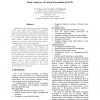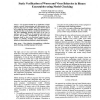44 search results - page 1 / 9 » Polymorphic Worm Detection Using Structural Information of E... |
RAID
2005
Springer
13 years 9 months ago
2005
Springer
Abstract. Network worms are malicious programs that spread automatically across networks by exploiting vulnerabilities that affect a large number of hosts. Because of the speed at...
ANCS
2006
ACM
13 years 10 months ago
2006
ACM
The fast spreading worm is becoming one of the most serious threats to today’s networked information systems. A fast spreading worm could infect hundreds of thousands of hosts w...
ACSAC
2004
IEEE
13 years 8 months ago
2004
IEEE
Software security assurance and malware (trojans, worms, and viruses, etc.) detection are important topics of information security. Software obfuscation, a general technique that ...
IAW
2003
IEEE
13 years 9 months ago
2003
IEEE
- Use offormal methods in any application scenario requires a precise characterization and representation of the properties that need to be verified The target, which is desired ri...
WORM
2003
13 years 5 months ago
2003
This paper presents DOME, a host-based technique for detecting several general classes of malicious code in software executables. DOME uses static analysis to identify the locatio...


